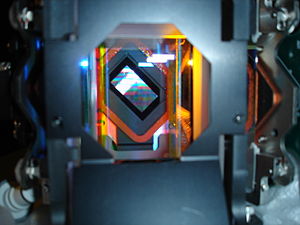
A digital projector, also called a digital projection display system, is a specialized computer display that projects an enlarged image on a movie screen. Such devices are commonly used in presentations.
There are two main types of digital projection display systems. One for each of the primary colors (red, green, and blue), the older, less expensive type employs three transparent liquid-crystal-display ( LCD ) panels. Depending on the image data received from the computer, the light transitivity of each pixel varies. The light from a lamp is directed through the LCD panels, collimated using a lens, and projected onto a screen.
Where a “slide” consists of the three LCD panels placed close together near the focal point of the projection lens, the overall construction of the device is similar to that of a slide projector. Advantages of LCD technology include high image resolution, ease of brightness, and contrast adjustment.
A newer, more expensive scheme is known as Digital Light Processing (DLP), a proprietary technology developed by Texas Instruments. Tiny mirrors are used instead of transparent panels, in a DLP display. Each mirror represents one pixel. The light, is reflected from it, rather than passing through the panel. Varying the amount of light that reaches the projection lens from each pixel, the mirrors move back and forth. By passing the light from the lamp through a rotating wheel with red, green, and blue filters, the color is obtained. In a rapid rotating sequence, this subjects the mirrors to light at each of the primary colors. The result is a color-modulated image that the human eye sees as natural color. Advantages of DLP technology include lack of pixilation, high contrast, light weight.
The term digital projector is sometimes used for a program that facilitates the viewing of three-dimensional (3D), interactive, full-motion audio-visual files on a personal computer. Versions can be downloaded from the Internet, and are available for both IBM-compatible and Macintosh computers. They can be used as plug-ins for popular browsers for viewing animated Web-page content. A broadband connection should be used because of the high-speed, interactive nature of the content, and because the transmitted files are often large, for optimum performance on the Internet.

